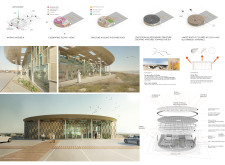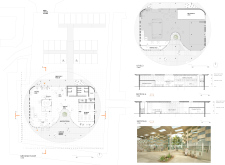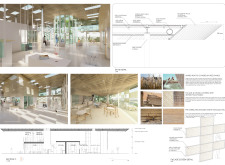5 key facts about this project
Design representations include the use of organic forms and locally sourced materials, aligning the structure with its surroundings. The visitor center promotes sustainability while offering insights into ecosystem conservation and local wildlife education.
Architectural Integrity and Material Use
A critical aspect of the project's design is its commitment to sustainability. The visitor center utilizes pre-fabricated rammed earth for its walls, providing excellent thermal performance and durability. This material choice reflects a deep respect for the local environment and heritage. The facade employs woven palm panels and reed elements, creating visual continuity with the natural habitat while promoting thermal efficiency. The roof structure, designed to mirror the shape of flamingo wings, integrates eco-friendly materials and further emphasizes the connection between the building and the wildlife it supports.
Inside, the architectural layout promotes fluidity and engagement. Large glass panels allow natural light to permeate interior spaces and offer panoramic views of the wetlands. Multi-functional areas, including event spaces, cafes, and educational facilities, cater to various visitor needs while reinforcing the center’s purpose as a hub for ecological awareness.
Innovative Design Approaches
This project distinguishes itself through its harmonious relationship with nature, prioritizing ecological sensitivity in both form and function. The circular and flowing designs are intentionally created to facilitate movement, echoing the natural forms found in the wetlands. The open terraces and viewing decks are strategically positioned to encourage visitor interaction with the wildlife, enhancing the educational experience.
Furthermore, the utilization of locally sourced materials not only supports regional craftsmanship but also minimizes the carbon footprint associated with transporting materials. The architectural design embraces sustainability without compromising aesthetic qualities, thus contributing to a better understanding of environmental stewardship.
The design of the Abu Dhabi Flamingo Visitor Center is a meticulous interpretation of ecological architecture, emphasizing sustainable practices and community engagement. To gain a deeper understanding of its architectural plans, sections, designs, and innovative ideas, readers are encouraged to explore the project presentation for a comprehensive view of its features and functionalities.


























